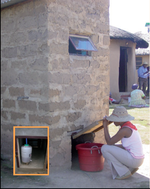Blackwater storage tanks

When urine or faeces cannot be used immediately or transported using a Conveyance Technology (i.e. Jerrycans or oil drums) it can be stored onsite in containers or tanks. The Storage Tank must then be moved or emptied into another container for transport.

Urine
The Storage Tank should be appropriately sized to accommodate the number of users and the time required to sanitise the urine. Urine collected in small containers (up to 20 litres) can be easily transported and used as fertiliser in the household's own vegetable garden. Larger containers, filled with urine have to be collected by a vehicle and can therefore be transported over longer distances.
The storage guidelines for urine correspond to the temperature of storage and the intended crop, but all urine should be stored for at least 1 month (see WHO guidelines for specific storage and application guidelines). Smaller volume Storage Tanks can be used and transported to another, centralized Storage Tank at, or close to, the point of use (i.e. the farm).
Mobile Storage Tanks should be plastic or fibreglass, but permanent Storage Tanks can be made of concrete or plastic. Metal should be avoided as it can be easily corroded by the high pH of stored urine.
With storage time, a layer of organic sludge and precipitated minerals (primarily calcium and magnesium phosphates) will form on the bottom of the tank. Any tank used for urine storage should have an opening large enough so that it can be cleaned and/ or pumped out.
Neither the Storage Tank, nor the collection pipes should be ventilated, but they both need to be pressure equalized. If the Storage Tank is emptied using a vacuum truck, the inflow of air must be maintained at a sufficient rate to ensure that the tank does not implode due to the vacuum.
If the Storage Tank is connected to the toilet or urinal directly with a pipe, care should be taken to minimize the length of the pipe since precipitates will accumulate. If pipes must be used, they should have a steep slope (greater than 1% slope), no sharp angles, large diameters (up to 110mm for underground pipes) and be easily removable in case of blockages.
To minimize odours, the tank should be filled from the bottom, i.e. the urine should flow down through a pipe and be released near the bottom of the tank; this will prevent the urine from spraying as well as prevent back-flow.
Faeces
Oil drums, or half drums, can be placed directly beneath a toilet to collect faeces. Ash or other drying material has to be added regularly to prevent smells. Toilet paper can also be collected in the oil drum.
| Advantages | Disadvantages |
|---|---|
| - Can be built and repaired with locally available materials - No electrical energy required |
- Mild to strong odour when opening and emptying tank (depending on storage conditions) |
Adequacy
Containers are not suitable for the collection of mixed urine and excreta.
Collection of oil drums and containers at community level has to be made functioning beforehand and measures have to be taken to guarantee hygienic safety. Sizes and weights must be manageable.
Long-term storage is the best way to sanitize urine without the addition of chemicals or mechanical processes.
Urine Storage Tanks can be used in virtually every environment; tanks should be well-sealed to prevent leaks, infiltration and evaporation. Urine Storage Tanks can be installed indoors, outdoors, above ground and below ground depending on the climate, space available, and soil.
Health Aspects / Acceptance
The risk of disease transmission from stored urine is low. Extended storage with storage times greater than 6 months provides near complete sanitation.
Maintenance
A viscous sludge will accumulate on the bottom of the Storage Tank. When the Storage Tank is emptied, the sludge will usually be emptied along with the urine, but if a tap is used and the tank is never fully emptied, it may require desludging. The desludging period will depend on the composition of the urine and the storage conditions.
Mineral and salt build-up in the tank or on connecting pipes can be manually removed (sometimes with difficulty) or can be dissolved with a strong acid (24% acetic).
Manual, videos, and links
References
- GTZ (2007). Technical data sheet, urine diversion: Piping and storage. GTZ, Germany. Available: www.gtz.de
- Kvarnström, E., et al. (2006). Urine Diversion - One step towards sustainable sanitation. Report 2006-1. Ecosan Res: Ecosan Publication Series, Stockholm. Available: www.ecosanres.org
- WHO (2006). Guidelines for the safe use of wastewater, excreta and greywater- Volume 4: Excreta and greywater use in agriculture. WHO, Geneva. Available: www.who.int
- General information about Oil drums and containers www.gtz.de/ecosan www.waste.nl
- The Philippines www.caps.ph
- India www.sulabhinternational.org
Acknowledgements
The material on this page was adapted from:
Tilley, E. et al. (2008). Compendium of Sanitation Systems and Technologies, published by Sandec, the Department of Water and Sanitation in Developing Countries of Eawag, the Swiss Federal Institute of Aquatic Science and Technology, Dübendorf, Switzerland.
The publication is available in English, French, and will be made available in Spanish. Available in the IRC Digital Library